gearbox RENAULT SCENIC 2011 J95 / 3.G Engine And Peripherals Siemens Injection Workshop Manual
[x] Cancel search | Manufacturer: RENAULT, Model Year: 2011, Model line: SCENIC, Model: RENAULT SCENIC 2011 J95 / 3.GPages: 329, PDF Size: 1.71 MB
Page 17 of 329
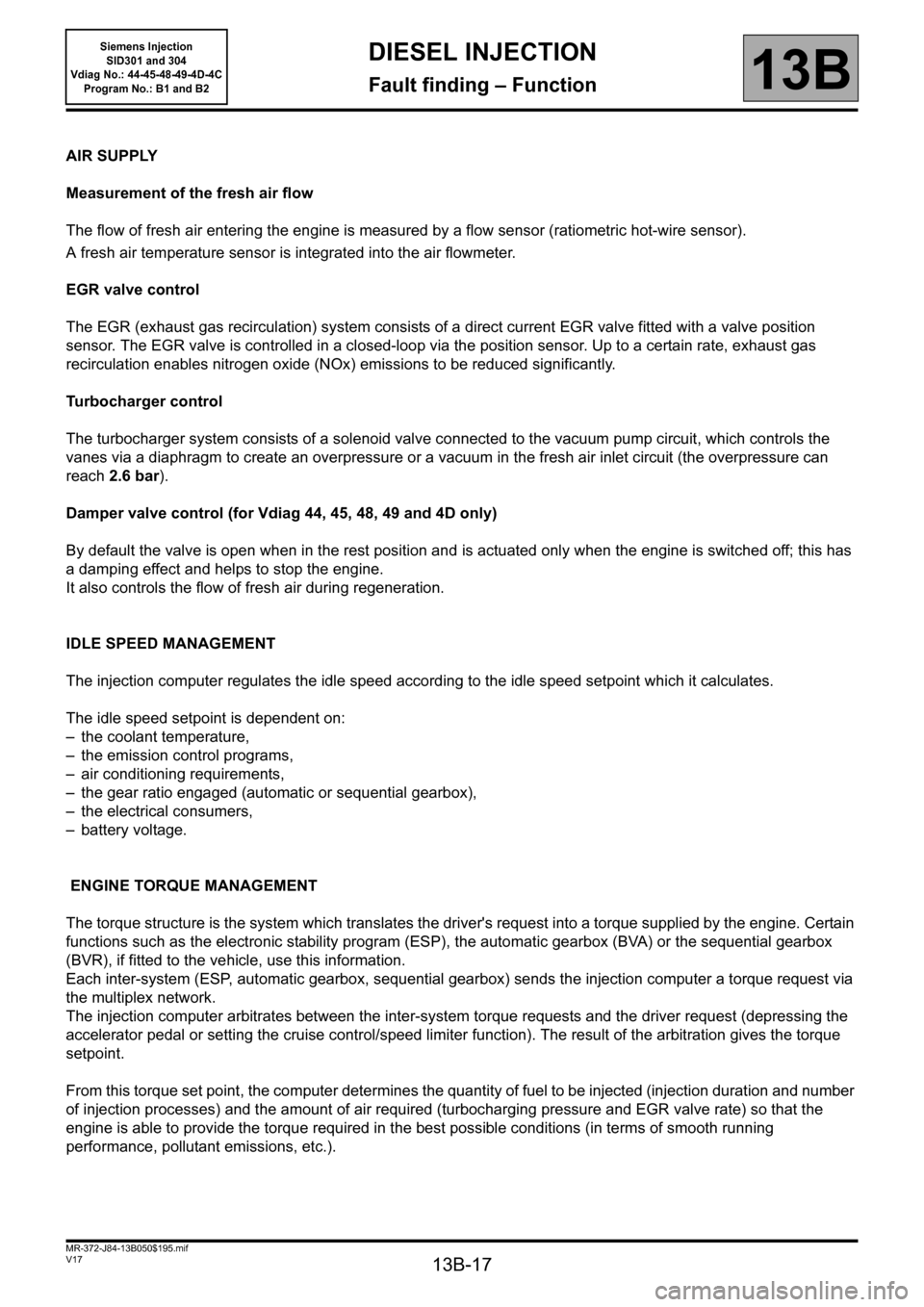
13B-17
MR-372-J84-13B050$195.mif
V17
Siemens Injection
SID301 and 304
Vdiag No.: 44-45-48-49-4D-4C
Program No.: B1 and B2DIESEL INJECTION
Fault finding – Function13B
AIR SUPPLY
Measurement of the fresh air flow
The flow of fresh air entering the engine is measured by a flow sensor (ratiometric hot-wire sensor).
A fresh air temperature sensor is integrated into the air flowmeter.
EGR valve control
The EGR (exhaust gas recirculation) system consists of a direct current EGR valve fitted with a valve position
sensor. The EGR valve is controlled in a closed-loop via the position sensor. Up to a certain rate, exhaust gas
recirculation enables nitrogen oxide (NOx) emissions to be reduced significantly.
Turbocharger control
The turbocharger system consists of a solenoid valve connected to the vacuum pump circuit, which controls the
vanes via a diaphragm to create an overpressure or a vacuum in the fresh air inlet circuit (the overpressure can
reach 2.6 bar).
Damper valve control (for Vdiag 44, 45, 48, 49 and 4D only)
By default the valve is open when in the rest position and is actuated only when the engine is switched off; this has
a damping effect and helps to stop the engine.
It also controls the flow of fresh air during regeneration.
IDLE SPEED MANAGEMENT
The injection computer regulates the idle speed according to the idle speed setpoint which it calculates.
The idle speed setpoint is dependent on:
– the coolant temperature,
– the emission control programs,
– air conditioning requirements,
– the gear ratio engaged (automatic or sequential gearbox),
– the electrical consumers,
– battery voltage.
ENGINE TORQUE MANAGEMENT
The torque structure is the system which translates the driver's request into a torque supplied by the engine. Certain
functions such as the electronic stability program (ESP), the automatic gearbox (BVA) or the sequential gearbox
(BVR), if fitted to the vehicle, use this information.
Each inter-system (ESP, automatic gearbox, sequential gearbox) sends the injection computer a torque request via
the multiplex network.
The injection computer arbitrates between the inter-system torque requests and the driver request (depressing the
accelerator pedal or setting the cruise control/speed limiter function). The result of the arbitration gives the torque
setpoint.
From this torque set point, the computer determines the quantity of fuel to be injected (injection duration and number
of injection processes) and the amount of air required (turbocharging pressure and EGR valve rate) so that the
engine is able to provide the torque required in the best possible conditions (in terms of smooth running
performance, pollutant emissions, etc.).
Page 18 of 329
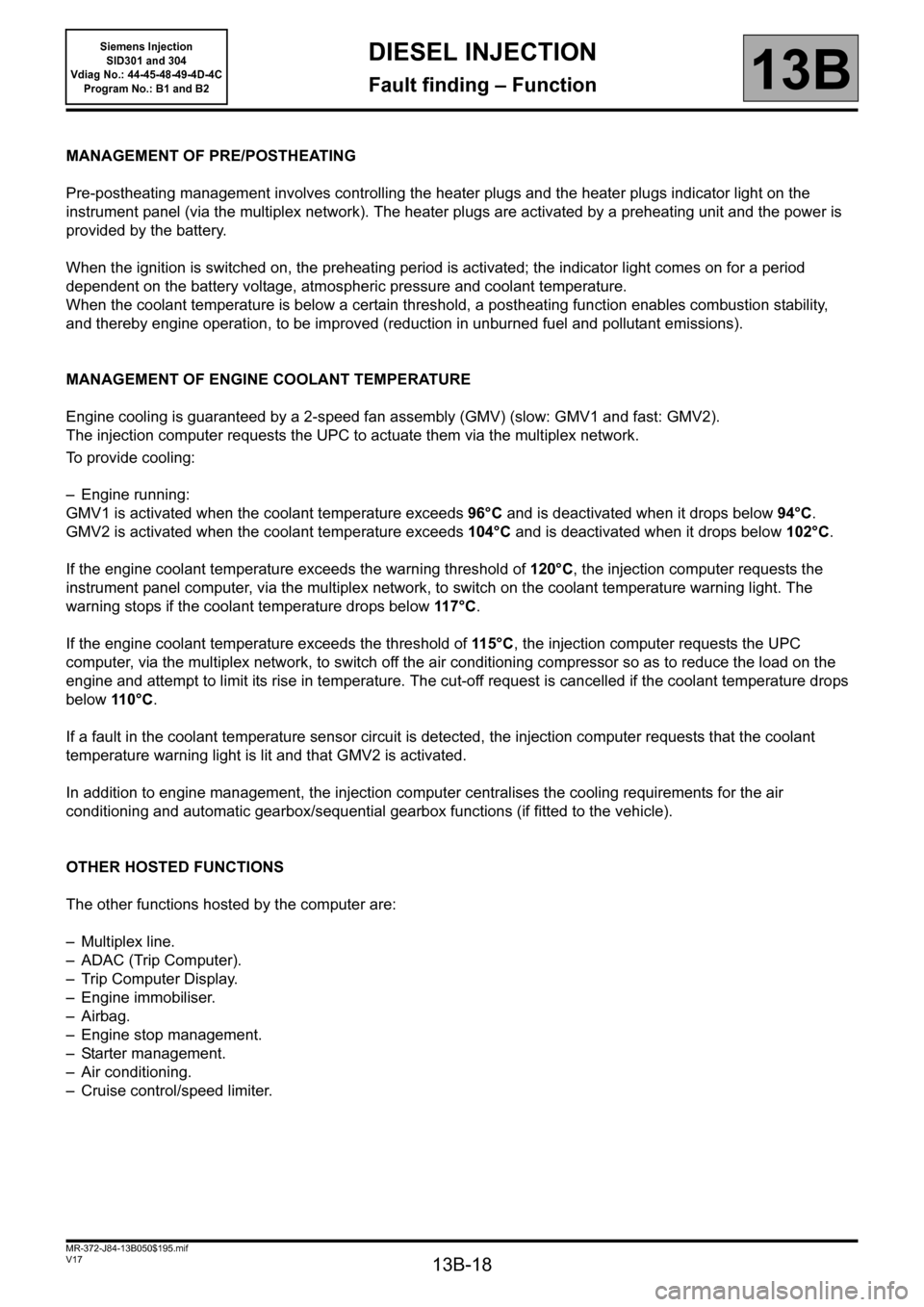
13B-18
MR-372-J84-13B050$195.mif
V17
Siemens Injection
SID301 and 304
Vdiag No.: 44-45-48-49-4D-4C
Program No.: B1 and B2DIESEL INJECTION
Fault finding – Function13B
MANAGEMENT OF PRE/POSTHEATING
Pre-postheating management involves controlling the heater plugs and the heater plugs indicator light on the
instrument panel (via the multiplex network). The heater plugs are activated by a preheating unit and the power is
provided by the battery.
When the ignition is switched on, the preheating period is activated; the indicator light comes on for a period
dependent on the battery voltage, atmospheric pressure and coolant temperature.
When the coolant temperature is below a certain threshold, a postheating function enables combustion stability,
and thereby engine operation, to be improved (reduction in unburned fuel and pollutant emissions).
MANAGEMENT OF ENGINE COOLANT TEMPERATURE
Engine cooling is guaranteed by a 2-speed fan assembly (GMV) (slow: GMV1 and fast: GMV2).
The injection computer requests the UPC to actuate them via the multiplex network.
To provide cooling:
– Engine running:
GMV1 is activated when the coolant temperature exceeds 96°C and is deactivated when it drops below 94°C.
GMV2 is activated when the coolant temperature exceeds 104°C and is deactivated when it drops below 102°C.
If the engine coolant temperature exceeds the warning threshold of 120°C, the injection computer requests the
instrument panel computer, via the multiplex network, to switch on the coolant temperature warning light. The
warning stops if the coolant temperature drops below 117 ° C.
If the engine coolant temperature exceeds the threshold of 11 5 ° C, the injection computer requests the UPC
computer, via the multiplex network, to switch off the air conditioning compressor so as to reduce the load on the
engine and attempt to limit its rise in temperature. The cut-off request is cancelled if the coolant temperature drops
below 110°C.
If a fault in the coolant temperature sensor circuit is detected, the injection computer requests that the coolant
temperature warning light is lit and that GMV2 is activated.
In addition to engine management, the injection computer centralises the cooling requirements for the air
conditioning and automatic gearbox/sequential gearbox functions (if fitted to the vehicle).
OTHER HOSTED FUNCTIONS
The other functions hosted by the computer are:
– Multiplex line.
– ADAC (Trip Computer).
– Trip Computer Display.
– Engine immobiliser.
– Airbag.
– Engine stop management.
– Starter management.
– Air conditioning.
– Cruise control/speed limiter.
Page 30 of 329
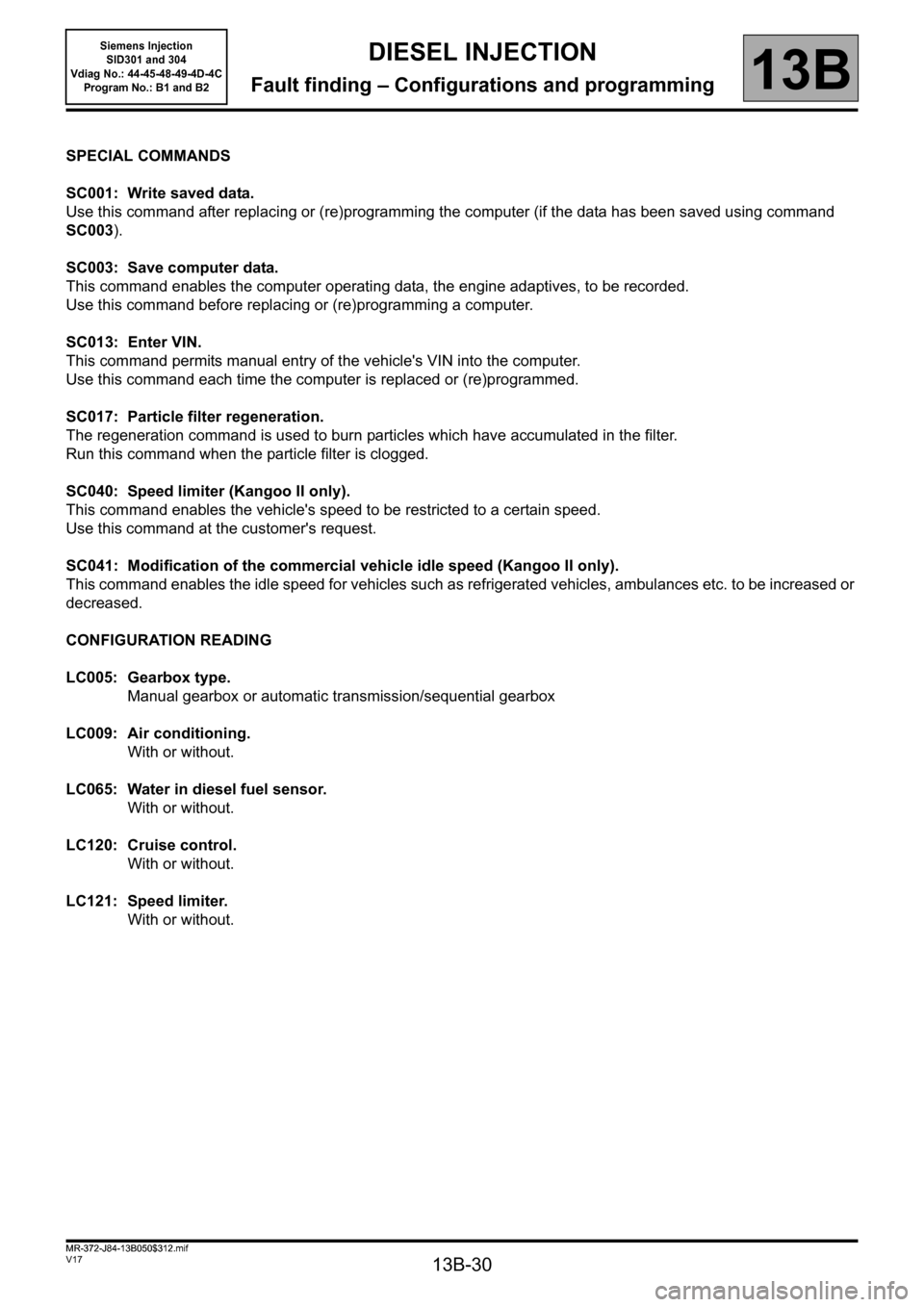
13B-30
MR-372-J84-13B050$312.mif
V17
13B
DIESEL INJECTION
Fault finding – Configurations and programming
SPECIAL COMMANDS
SC001: Write saved data.
Use this command after replacing or (re)programming the computer (if the data has been saved using command
SC003).
SC003: Save computer data.
This command enables the computer operating data, the engine adaptives, to be recorded.
Use this command before replacing or (re)programming a computer.
SC013: Enter VIN.
This command permits manual entry of the vehicle's VIN into the computer.
Use this command each time the computer is replaced or (re)programmed.
SC017: Particle filter regeneration.
The regeneration command is used to burn particles which have accumulated in the filter.
Run this command when the particle filter is clogged.
SC040: Speed limiter (Kangoo II only).
This command enables the vehicle's speed to be restricted to a certain speed.
Use this command at the customer's request.
SC041: Modification of the commercial vehicle idle speed (Kangoo II only).
This command enables the idle speed for vehicles such as refrigerated vehicles, ambulances etc. to be increased or
decreased.
CONFIGURATION READING
LC005: Gearbox type.
Manual gearbox or automatic transmission/sequential gearbox
LC009: Air conditioning.
With or without.
LC065: Water in diesel fuel sensor.
With or without.
LC120: Cruise control.
With or without.
LC121: Speed limiter.
With or without.
MR-372-J84-13B050$312.mif
Siemens Injection
SID301 and 304
Vdiag No.: 44-45-48-49-4D-4C
Program No.: B1 and B2
Page 164 of 329
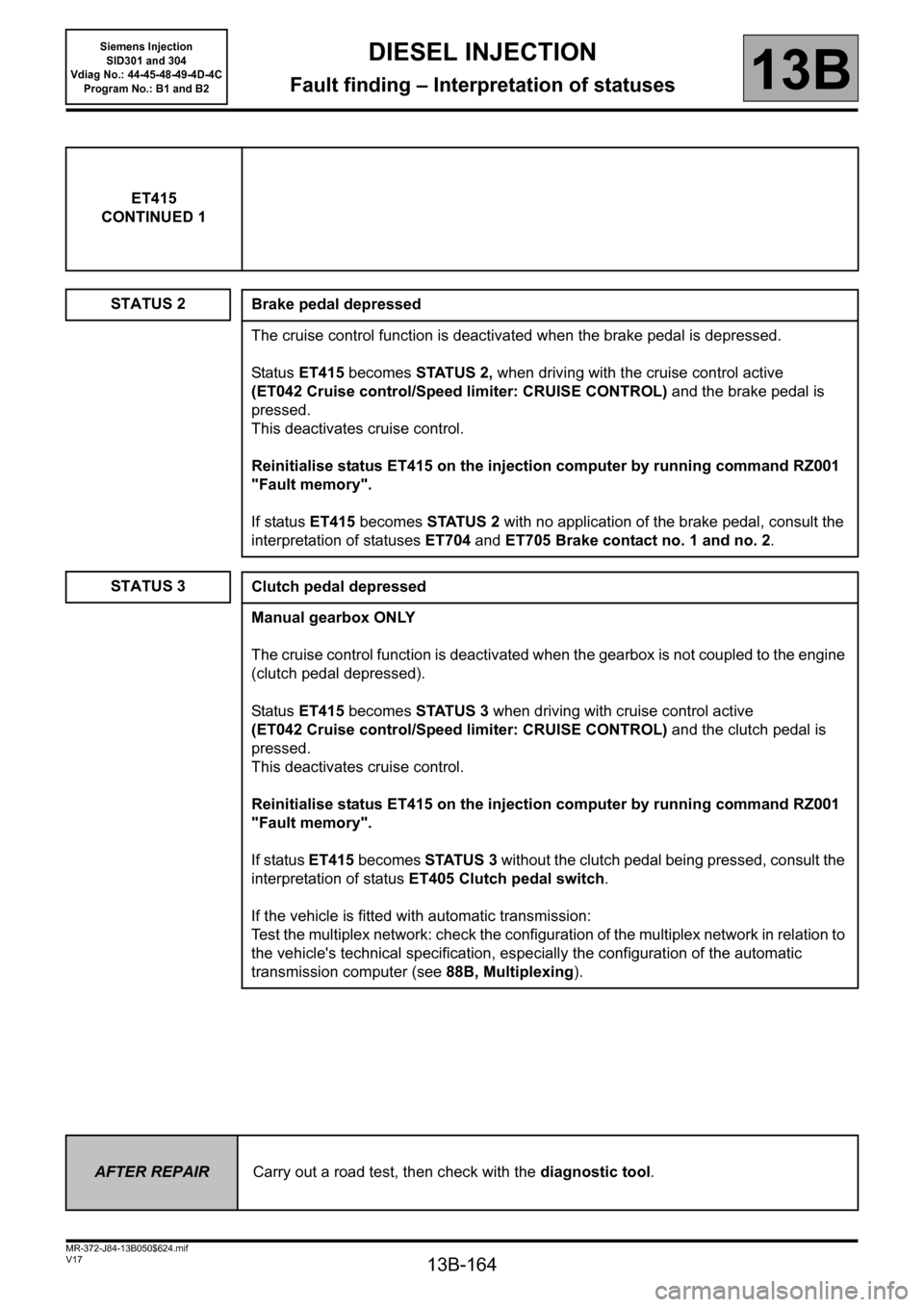
13B-164
MR-372-J84-13B050$624.mif
V17
Siemens Injection
SID301 and 304
Vdiag No.: 44-45-48-49-4D-4C
Program No.: B1 and B2DIESEL INJECTION
Fault finding – Interpretation of statuses13B
ET415
CONTINUED 1
STATUS 2
Brake pedal depressed
The cruise control function is deactivated when the brake pedal is depressed.
Status ET415 becomes STATUS 2, when driving with the cruise control active
(ET042 Cruise control/Speed limiter: CRUISE CONTROL) and the brake pedal is
pressed.
This deactivates cruise control.
Reinitialise status ET415 on the injection computer by running command RZ001
"Fault memory".
If status ET415 becomes STATUS 2 with no application of the brake pedal, consult the
interpretation of statuses ET704 and ET705 Brake contact no. 1 and no. 2.
STATUS 3Clutch pedal depressed
Manual gearbox ONLY
The cruise control function is deactivated when the gearbox is not coupled to the engine
(clutch pedal depressed).
Status ET415 becomes STATUS 3 when driving with cruise control active
(ET042 Cruise control/Speed limiter: CRUISE CONTROL) and the clutch pedal is
pressed.
This deactivates cruise control.
Reinitialise status ET415 on the injection computer by running command RZ001
"Fault memory".
If status ET415 becomes STATUS 3 without the clutch pedal being pressed, consult the
interpretation of status ET405 Clutch pedal switch.
If the vehicle is fitted with automatic transmission:
Test the multiplex network: check the configuration of the multiplex network in relation to
the vehicle's technical specification, especially the configuration of the automatic
transmission computer (see 88B, Multiplexing).
AFTER REPAIRCarry out a road test, then check with the diagnostic tool.
Page 166 of 329
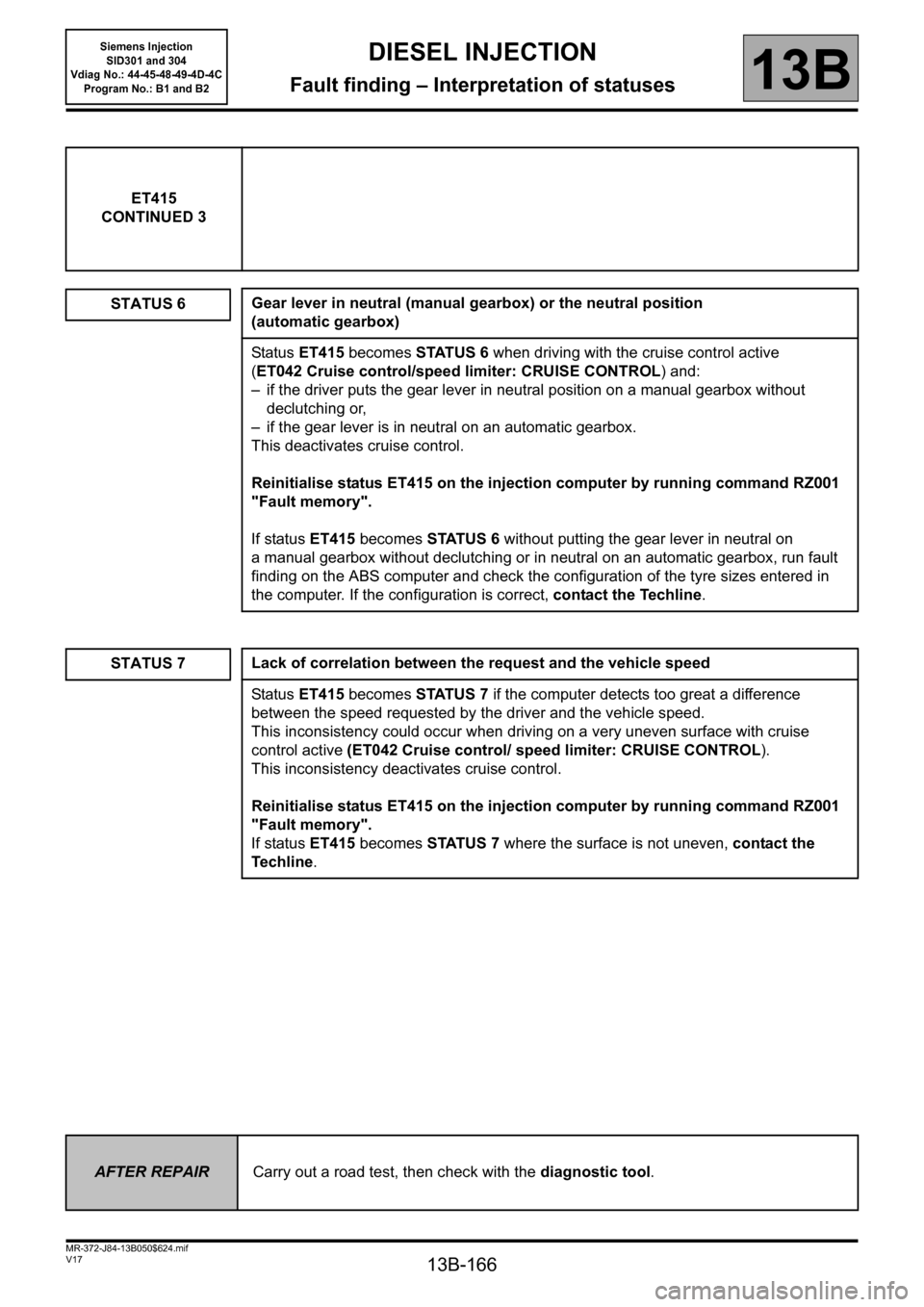
13B-166
MR-372-J84-13B050$624.mif
V17
Siemens Injection
SID301 and 304
Vdiag No.: 44-45-48-49-4D-4C
Program No.: B1 and B2DIESEL INJECTION
Fault finding – Interpretation of statuses13B
ET415
CONTINUED 3
STATUS 6
Gear lever in neutral (manual gearbox) or the neutral position
(automatic gearbox)
Status ET415 becomes STATUS 6 when driving with the cruise control active
(ET042 Cruise control/speed limiter: CRUISE CONTROL) and:
– if the driver puts the gear lever in neutral position on a manual gearbox without
declutching or,
– if the gear lever is in neutral on an automatic gearbox.
This deactivates cruise control.
Reinitialise status ET415 on the injection computer by running command RZ001
"Fault memory".
If status ET415 becomes STATUS 6 without putting the gear lever in neutral on
a manual gearbox without declutching or in neutral on an automatic gearbox, run fault
finding on the ABS computer and check the configuration of the tyre sizes entered in
the computer. If the configuration is correct, contact the Techline.
STATUS 7Lack of correlation between the request and the vehicle speed
Status ET415 becomes STATUS 7 if the computer detects too great a difference
between the speed requested by the driver and the vehicle speed.
This inconsistency could occur when driving on a very uneven surface with cruise
control active (ET042 Cruise control/ speed limiter: CRUISE CONTROL).
This inconsistency deactivates cruise control.
Reinitialise status ET415 on the injection computer by running command RZ001
"Fault memory".
If status ET415 becomes STATUS 7 where the surface is not uneven, contact the
Techline.
AFTER REPAIRCarry out a road test, then check with the diagnostic tool.
Page 167 of 329
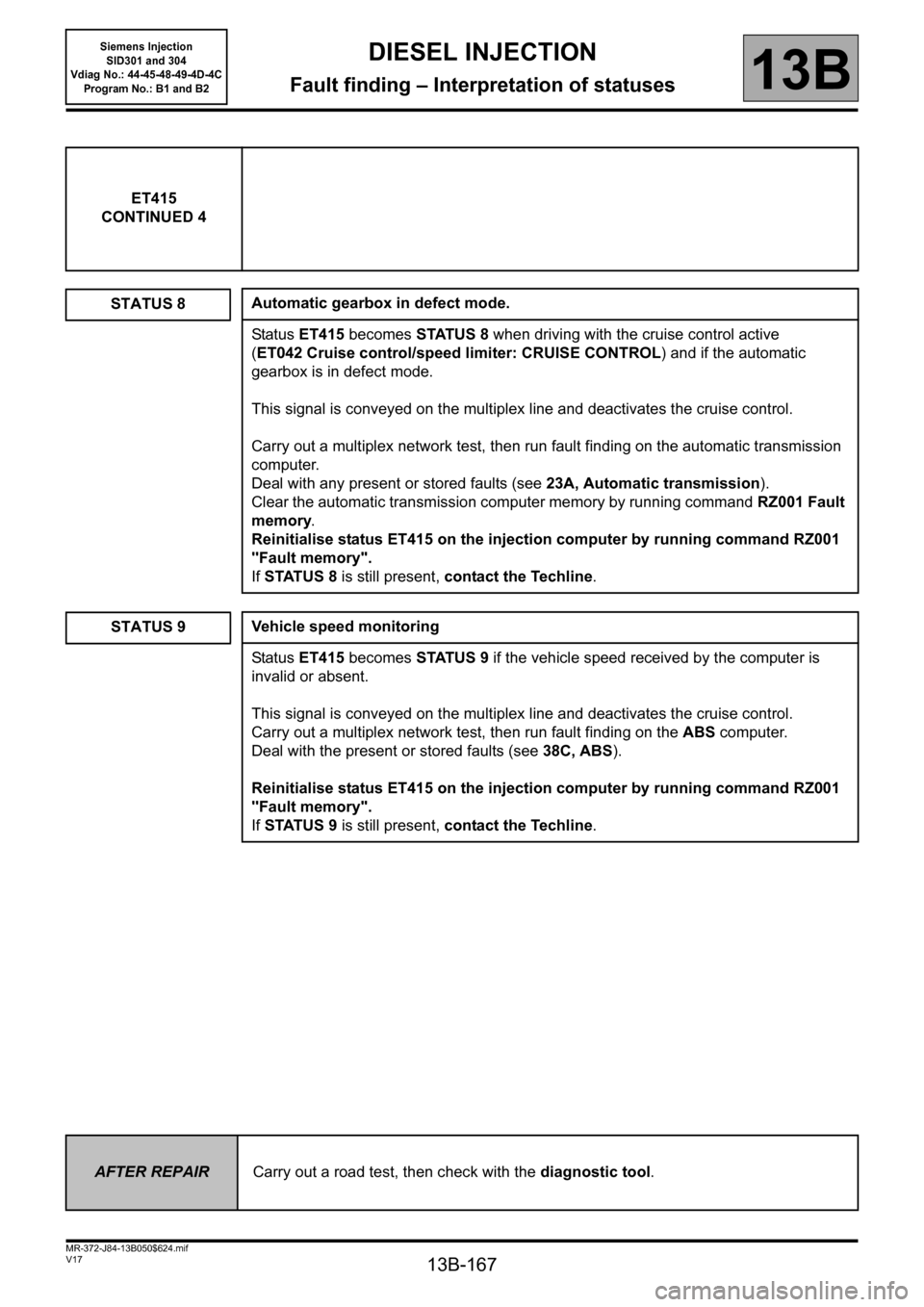
13B-167
MR-372-J84-13B050$624.mif
V17
Siemens Injection
SID301 and 304
Vdiag No.: 44-45-48-49-4D-4C
Program No.: B1 and B2DIESEL INJECTION
Fault finding – Interpretation of statuses13B
ET415
CONTINUED 4
STATUS 8
Automatic gearbox in defect mode.
Status ET415 becomes STATUS 8 when driving with the cruise control active
(ET042 Cruise control/speed limiter: CRUISE CONTROL) and if the automatic
gearbox is in defect mode.
This signal is conveyed on the multiplex line and deactivates the cruise control.
Carry out a multiplex network test, then run fault finding on the automatic transmission
computer.
Deal with any present or stored faults (see23A, Automatic transmission).
Clear the automatic transmission computer memory by running command RZ001 Fault
memory.
Reinitialise status ET415 on the injection computer by running command RZ001
"Fault memory".
If STATUS 8 is still present, contact the Techline.
STATUS 9Vehicle speed monitoring
Status ET415 becomes STATUS 9 if the vehicle speed received by the computer is
invalid or absent.
This signal is conveyed on the multiplex line and deactivates the cruise control.
Carry out a multiplex network test, then run fault finding on the ABS computer.
Deal with the present or stored faults (see38C, ABS).
Reinitialise status ET415 on the injection computer by running command RZ001
"Fault memory".
If STATUS 9 is still present, contact the Techline.
AFTER REPAIRCarry out a road test, then check with the diagnostic tool.
Page 292 of 329
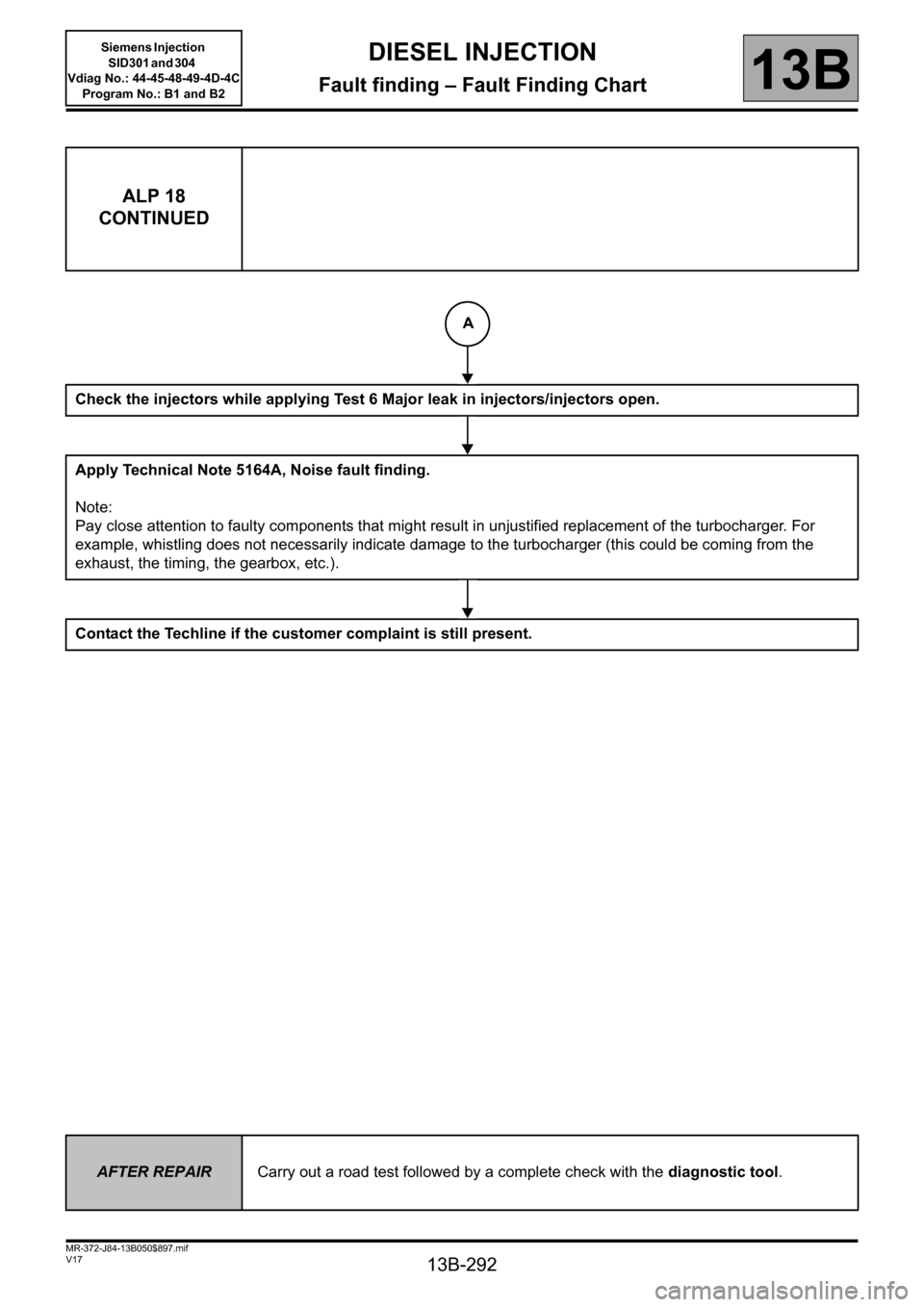
13B-292
MR-372-J84-13B050$897.mif
V17
DIESEL INJECTION
Fault finding – Fault Finding Chart
Siemens Injection
SID301 and 304
Vdiag No.: 44-45-48-49-4D-4C
Program No.: B1 and B2
13B
ALP 18
CONTINUED
Check the injectors while applying Test 6 Major leak in injectors/injectors open.
Apply Technical Note 5164A, Noise fault finding.
Note:
Pay close attention to faulty components that might result in unjustified replacement of the turbocharger. For
example, whistling does not necessarily indicate damage to the turbocharger (this could be coming from the
exhaust, the timing, the gearbox, etc.).
Contact the Techline if the customer complaint is still present.
AFTER REPAIRCarry out a road test followed by a complete check with the diagnostic tool.
A